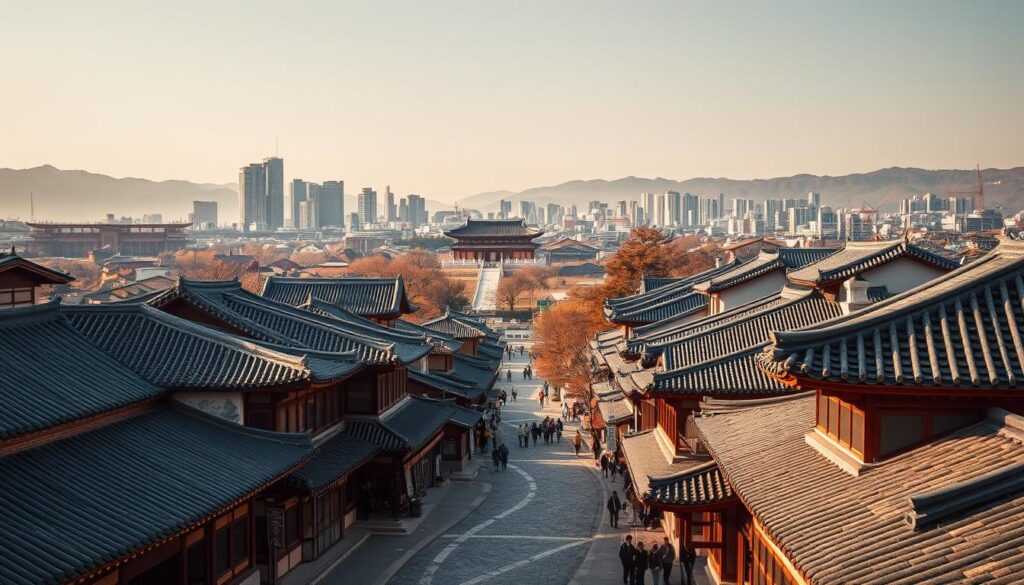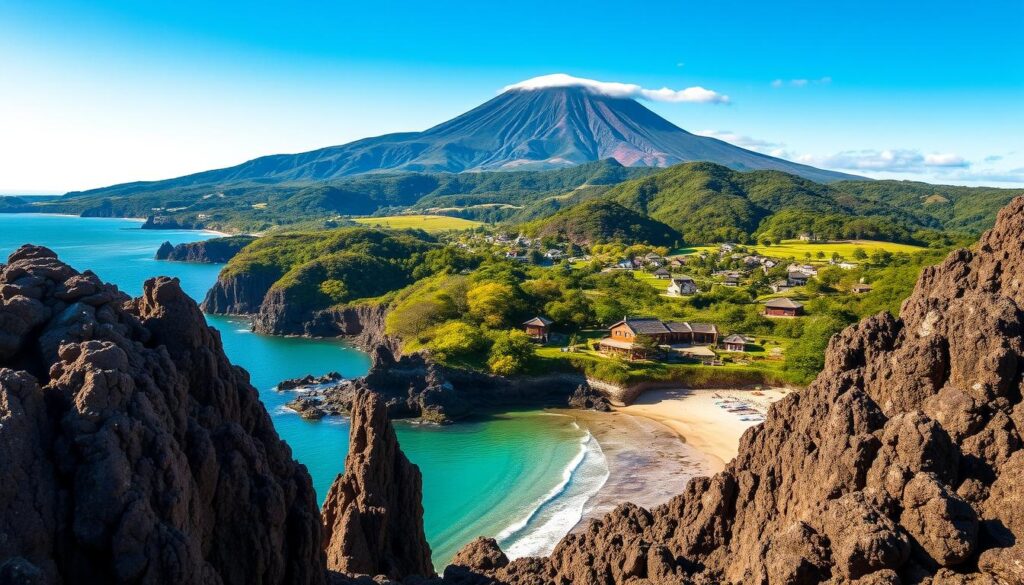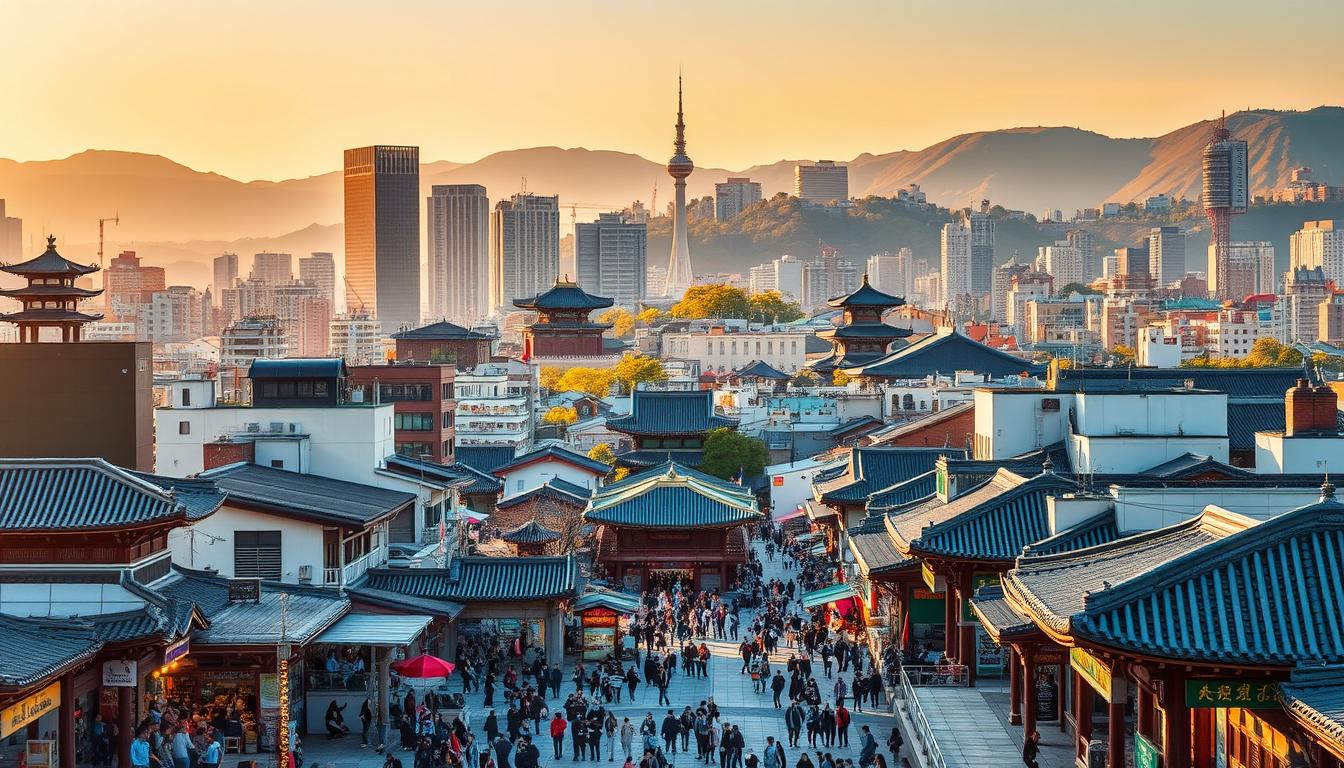Best Cities to Visit in Korea: Explore Top Urban Destinations for Tourists
Table of Contents
Imagine stepping into a world where ancient traditions meet modern technology. In South Korea, every city has its own story. You’ll find unforgettable experiences that mix rich culture with urban fun.
This guide will show you South Korea’s diverse cities. You’ll see Seoul’s busy streets and Busan’s coastal beauty. Each city has its own charm and secrets.
Your journey will show how South Korea connects its past and present. You’ll see historic palaces, cultural areas, and tech hubs. Each city offers a glimpse into Korea’s spirit.
Prepare to discover the magic of Korean cities. Here, tradition and innovation meet, and every corner has a story to tell.
Understanding South Korea’s Urban Landscape
South Korea is a mix of modern cities and traditional culture. Its small size makes it easy to see different landscapes and cities. It’s a top spot for travelers who love adventure.
Exploring South Korea’s cities shows a cool contrast. You’ll see modern tech and old traditions. Places like Seoul and Busan offer amazing experiences for all travelers.
Modern vs Traditional City Experiences
Korean cities mix old and new perfectly. In Seoul, you’ll see modern skyscrapers next to ancient palaces. You can find:
- Ancient temples near high-tech areas
- Traditional markets next to modern malls
- Old neighborhoods turned into cultural spots
Transportation Between Korean Cities
Getting around Korea’s cities is easy. The country has a reliable public transit system. You can use:
- Fast KTX trains
- Wide bus networks
- Flights for longer trips
Best Seasons to Visit Korean Cities
Choosing the right time to visit can make your trip better. The best months are:
- Spring (April to June): Beautiful cherry blossoms and nice weather
- Autumn (September to November): Cool air and amazing fall colors
Every season has its own fun. From spring festivals to autumn events, your trip will be unforgettable.
Seoul: The Dynamic Capital of South Korea
Welcome to Seoul, a city that mixes old traditions with new tech. It’s the heart of Korea’s attractions, giving visitors a unique urban experience. This city shows the best of South Korea’s vibrant culture.
Located in the northwest, Seoul has over 9.7 million people. It’s the top spot in Korea for visitors. The city keeps its history alive while moving forward with technology.
Historical Landmarks and Palaces
Discover Seoul’s history through its stunning palaces and sites. Key spots include:
- Gyeongbokgung Palace: The largest royal palace from the Joseon Dynasty
- Changdeokgung Palace: A UNESCO World Heritage site with beautiful secret gardens
- Bukchon Hanok Village: A preserved traditional Korean neighborhood
Modern Entertainment Districts
Seoul’s entertainment scene is famous worldwide. The Gangnam area is a top spot for nightlife, shopping, and entertainment.
Shopping and Cultural Experiences
| Shopping District | Key Attractions | Average Cost |
|---|---|---|
| Namdaemun Market | Traditional street market | $5-10 per item |
| Myeongdong | Modern shopping and cosmetics | $20-50 per purchase |
| Dongdaemun Design Plaza | Contemporary fashion and design | $30-100 per item |
Visitors can dive into Seoul’s cultural scene. From traditional tea to K-pop shows, there’s something for everyone. With great public transport and lots to see, Seoul is a city you won’t forget.
Busan: Coastal Charm and Maritime Culture
Discover Busan, a vibrant coastal gem in South Korea. It offers a mix of urban excitement and maritime culture. As the second-largest city, Busan is a top choice for travelers, providing an unforgettable experience.
Your Korean travel guide wouldn’t be complete without Busan. The city has stunning coastal views and rich cultural experiences. These make it stand out from other cities.
- Haeundae Beach: A 24-hour free attraction with pristine sandy shores
- Jagalchi Market: Korea’s largest seafood market with fresh local cuisine
- Gamcheon Culture Village: A colorful artistic neighborhood with free entry
- Haedong Yonggungsa Temple: A scenic Buddhist temple open from 5 AM to 7:30 PM
Busan is known as the “California of Korea” for its laid-back coastal vibe. Travelers usually need 3 days to see all it has to offer. The Visit Busan Pass helps you visit many attractions, like the Diamond Bay Yacht cruise and Songdo Marine Cable Car.
Don’t miss the weekend drone light show at Gwangalli Beach. It happens every Saturday evening. With its ocean views, world-class dining, and mix of modern and traditional, Busan is an incredible destination for all.
Best Cities to Visit in Korea for Cultural Immersion
Korea offers travelers a unique journey into cultural depth. Its top cities are filled with authentic experiences. You’ll find places that bring centuries-old traditions to life and show off modern Korean heritage.

When you explore Korea’s must-visit cities, some really stand out. They are known for their cultural preservation and experiences.
Traditional Architecture and Heritage Sites
Places like Jeonju and Seoul are home to stunning traditional architecture. Their Hanok villages give visitors a real look at Korea’s past:
- Bukchon Hanok Village in Seoul
- Jeonju Hanok Village with over 800 traditional Korean houses
- Gyeongju’s historic districts
Local Festivals and Events
Dive into Korea’s vibrant cultural celebrations. Many cities host events that show off local customs, arts, and community spirit.
Authentic Korean Cuisine Experiences
Exploring Korean cuisine is a big part of cultural immersion. Jeonju, known as the birthplace of Korean cuisine, offers amazing food experiences:
- Traditional tea ceremonies
- Local cooking workshops
- Street food tours
- Traditional restaurant experiences
Your journey through Korea’s cities will be unforgettable. You’ll explore tradition, cuisine, and living history.
Gyeongju: The Museum Without Walls
Explore Gyeongju, a top city in South Korea that takes you back in time. Known as the “Museum Without Walls,” it keeps alive the Silla Kingdom’s legacy. This kingdom’s history spans an amazing 1,000 years.
Start your journey through Korean city attractions with Gyeongju’s UNESCO World Heritage sites. These sites date back to A.D. 751. They house incredible historical treasures:
- 64 ancient pagodas
- Over 50 Buddhist statues
- 122 temple ruins
- Remarkable archaeological sites
Don’t miss these top spots in Gyeongju. The Bulguksa Temple showcases stunning Buddhist architecture. Wolji Pond (Anapji Pond) offers stunning views from A.D. 674. The Gyeongju National Museum has a vast collection of artifacts that highlight the city’s ancient history.
Here are some travel tips for Gyeongju:
- Plan for at least two days to see everything
- Bring cash, as many places don’t take foreign cards
- Exchange money in big cities like Seoul or Busan
- Expect fewer activities in the mornings before 10 AM
Getting to Gyeongju is easy with many transport options. The high-speed train from Seoul takes about two and a half hours. It’s an hour and a half from Busan and over two hours from Daegu.
Gyeongju isn’t just a destination—it’s a living museum that tells the story of Korea’s rich cultural heritage.
Jeju Island: Natural Beauty and Island Life
Discover Jeju Island, a breathtaking South Korea travel destination. It offers a unique blend of natural wonders and cultural experiences. This volcanic island is one of the best cities to visit in Korea, with an extraordinary landscape.

Volcanic Landscapes: A Geological Wonderland
Jeju Island is known for its remarkable volcanic features. The island’s centerpiece is Hallasan Mountain, standing at 1,947 meters. It’s South Korea’s highest peak. Visitors can explore fascinating geological formations like the Manjanggul Lava Tube, which stretches over 13 kilometers underground.
- Hallasan Mountain: 1,947 meters tall
- Manjanggul Cave: Over 13 kilometers long
- Seongsan Ilchulbong: Volcanic cone formed over 100,000 years ago
Beach Activities and Water Sports
Your adventure in South Korea continues with Jeju’s pristine beaches. The island offers many water activities for outdoor enthusiasts. From Hyeopjae Beach to the surrounding coastal areas, you’ll find perfect spots for swimming, surfing, and relaxing.
| Beach | Activities | Unique Feature |
|---|---|---|
| Hyeopjae Beach | Swimming, Sunbathing | Crystal clear waters |
| Jungmun Beach | Surfing, Water Sports | Professional surf spots |
Local Island Culture
Immerse yourself in Jeju’s distinctive culture. The island is renowned for specialties like black pork and unique citrus products. The Jeju Olle Trail, spanning 425 kilometers, offers hikers an incredible way to explore the island’s diverse landscapes.
“Jeju Island is not just a destination, it’s an experience that captures the heart of Korean natural beauty and cultural richness.”
With an average recommended stay of 5-6 days, Jeju Island promises an unforgettable journey. It’s one of the most captivating best cities to visit in Korea.
Incheon: Gateway to Korea
Incheon is a top Korean city that you must see. It’s a mix of old history and new tech. It’s just 28 miles west of Seoul and is Korea’s main entry point. Here, you’ll find amazing sights and experiences.
Incheon’s cityscape is a key reason it’s a top spot in South Korea. With a population of 3,002,172, it has a rich history and modern growth. You can see many attractions that show its unique side:
- Songdo Central Park – A futuristic urban development
- Wolmido Island – Scenic recreational area
- Incheon Chinatown – Largest in Korea
- Jayu Park – Commemorating historical liberation
The city is more than just a tourist spot. It’s also a hub for global businesses thanks to the Incheon Free Economic Zone (IFEZ). It shows Korea’s forward-thinking in international trade. It’s also known for the Incheon Landing during the Korean War, linking the past to today.
If you want to see Korea’s vibrant city life, Incheon is the place. It has history, modern buildings, and cultural experiences. This city is a must-visit for an unforgettable trip.
Daegu: Technology and Textile Hub
Discover Daegu, a fascinating city in South Korea. It’s where technology meets cultural heritage. Daegu is the country’s fourth-largest city, blending modern tech with traditional textiles.
Exploring Daegu reveals its unique charm. It’s a city where old meets new, perfect for curious travelers.
Shopping and Textile Experience
Daegu is known for its textile markets. Seomun Market is a highlight with over 4,000 shops. It offers a real shopping experience:
- Traditional textile markets
- Modern fashion boutiques
- Handcrafted textile products
Cultural Attractions
The city has amazing cultural sites. They show its history and modern spirit:
- Donghwasa Temple – Founded in 493 AD
- Daegu National Museum – Over 30,000 historical artifacts
- Kim Gwangseok-gil Street – A 350-meter artistic alley
Local Specialties and Experiences
Daegu has unique experiences. It stands out among Korean cities:
| Attraction | Highlights | Entry Price |
|---|---|---|
| 83 Tower | 202-meter observation tower | €7-€9 |
| Daegu Art Museum | Contemporary art exhibits | €5 (adults) |
| Yangnyeongsi Museum | Traditional medicine history | €2.50 |
Daegu is great for tech, textiles, or culture. It offers an unforgettable journey through South Korea’s most dynamic city.
Gwangju: Art and Democracy
Gwangju is a standout city in Korea, known for its deep history. It’s South Korea’s sixth-largest city, showing the power of democracy and art.
Every Korean travel guide should highlight Gwangju’s history. The May 18 Democratic Uprising of 1980 made Gwangju famous worldwide. It became a symbol of resistance and freedom.
- Visit the May 18th National Cemetery, featuring a 130-foot memorial monument
- Explore the Gwangju National Museum’s historical artifacts
- Experience the vibrant Gwangju Biennale contemporary art exhibition
Gwangju is a haven for art lovers. It’s filled with creativity, from galleries to art streets. The biennial events draw artists and fans from around the world.
| Cultural Highlight | Description |
|---|---|
| Gwangju Biennale | International contemporary art exhibition held every two years |
| May 18th Memorial Park | Commemorates the democratic uprising and its victims |
| Art Street | Hosts frequent art events and exhibitions |
Gwangju is a must-see for those looking for deep experiences in South Korea. It offers a mix of history, art, and resilience. The city is a treasure trove of Korean heritage, waiting to be explored.
Conclusion: Planning Your Korean City Adventure
Your trip through South Korea’s cities will be unforgettable. You’ll see the lively streets of Seoul and the beautiful coast of Busan. Each city has its own special mix of history and modern life.
When planning your trip, think about the seasons. Spring and autumn are the best times to visit. The weather is mild, perfect for exploring traditional villages and historic palaces. You can also enjoy outdoor festivals.
Seoul, Busan, and Gyeongju offer different views of Korean culture. You can dive into ancient history or modern city life. Each place has its own unique charm.
Planning well is important for a great trip. Use the public transport system to move easily between cities. Whether you want to try food in Jeonju, see art in Gwangju, or see tech in Incheon, you’ll find something special.
Your adventure in Korea is waiting. It will be a mix of history, culture, and fun. With good planning and an open mind, you’ll see why Korea’s cities are so amazing.
FAQ
What are the best cities to visit in South Korea?
When is the best time to visit Korean cities?
How easy is it to travel between cities in South Korea?
Is South Korea expensive for tourists?
What should I know about Korean cultural etiquette?
Do I need to speak Korean to travel in South Korean cities?
What are must-try foods in Korean cities?
Is public transportation good in Korean cities?
What are some unique cultural experiences in Korean cities?
How safe are Korean cities for tourists?
Source Links
- Best Cities in South Korea: Where to Visit | The Dragon Trip – https://thedragontrip.com/blog/south-korea/best-cities-to-visit-south-korea/
- South Korea: 7 must-visit cities in the Land of the Morning Calm – https://www.en-vols.com/en/getaways/travel/south-korea-cities-visit/
- Best places to visit in South Korea – https://www.lonelyplanet.com/articles/best-places-to-visit-in-south-korea
- 🌟 Top 7 cities to discover in South Korea! 🇰🇷 – https://www.lademeureduparc.fr/en/85770-the-7-must-visit-cities-in-south-korea-to-explore-without-delay/
- Highlights of South Korea | Abercrombie & Kent – https://www.abercrombiekent.com/tailormade/highlights-of-south-korea
- Seoul Travel Guide 2025: The Ultimate First-Timer’s Guide to South Korea’s Dynamic Capital – https://www.realjourneytravels.com/seoul-travel-guide/
- Adventure in the Land of the Morning Calm – Global Rescue – https://www.globalrescue.com/common/blog/detail/seoul-south-korea-adventure-travel/
- 5 Must-See Highlights of South Korea – https://www.exodustravels.com/us/insights/5-must-see-highlights-of-south-korea
- Ultimate Busan Itinerary: Explore The City In 1-3 Days – https://hungrypursuit.com/ultimate-busan-itinerary-1-3-days/
- Top 6 Places to visit in Busan | KoreaTravelEasy – https://www.koreatraveleasy.com/2024/06/22/top-6-places-to-visit-in-busan/
- 5 Immersive Cultural Experiences in Korea – https://www.adventure.travel/stories/5-immersive-experiences-in-korea
- ROK Cultural Immersion Program helps you explore South Korea – https://korea.stripes.com/travel/south-korea-cultural-immersion-program.html
- South Korea’s ‘Museum Without Walls’ Is A Unique City Brimming With Buddhist Temples And Palaces – Islands – https://www.islands.com/1757784/south-korea-golden-city-gyeongju-brims-buddhist-temples-palaces-like-kyoto/
- Visiting Gyeongju: Museum without Walls – Tips and Itineraries – Hit the Road Ket – https://hittheroadket.com/visiting-gyeongju-museum-without-walls-tips-and-itineraries/
- Jeju Island: A Journey Through South Korea’s Natural Wonders | Indian Ocean Islands – https://www.islaguru.com/articles/jeju-island-a-journey-through-south-koreas-natural-wonders
- Jeju Island Travel Guide: Discover the Hawaii of Korea – https://www.magnificentworld.com/things-to-do-in-jeju-island/
- Tasting Jeju: A Foodie’s Adventure and Scenic Escapes on Korea’s Paradise Island – https://www.ciee.org/go-abroad/college-study-abroad/blog/tasting-jeju-foodies-adventure-and-scenic-escapes-koreas-paradise-island
- Exploring Korea: We Travel to the Port Cities of Incheon, Busan, Yeosu and Sokcho (and Visit Seoul, Too) – Discover by Silversea – https://discover.silversea.com/destinations/asia/korea/exploring-koreas-port-cities/
- Incheon, South Korea – https://www.hellomondo.com/south-korea/incheon/
- 7 Top Cities to Visit in South Korea with Most Memorable Landmarks – https://www.traveloka.com/en-en/explore/destination/cities-to-visit-in-south-korea-trp/369584
- Top 20 Things to Do in Daegu, South Korea – https://nomadicsamuel.com/city-guides/daegu-travel-guide
- 16 Things to Do in Daegu: Top Activities & Attractions – https://mytravelation.com/daegu/
- Top 20 Things to Do Gwangju, South Korea – https://nomadicsamuel.com/city-guides/gwangju-travel-guide
- Exploring Gwangju: Top Things to Do in Gwangju Metropolitan City » Agoda: See The World For Less – https://www.agoda.com/travel-guides/south-korea/gwangju/exploring-gwangju-top-things-to-do-in-gwangju-metropolitan-city/
- Truely – https://truely.com/blog/best-cities-to-visit-in-south-korea?srsltid=AfmBOoqQsaHQX_HFXvrywmpSUTr3B8foCNM1vFE0x0cGJ1-6o0kucEby
- Korean Adventures: Your Insider’s Guide to Exploring South Korea » Agoda: See The World For Less – https://www.agoda.com/travel-guides/south-korea/korean-adventures-your-insiders-guide-to-exploring-south-korea/

